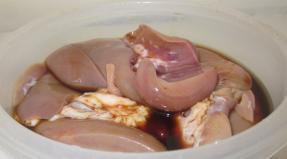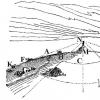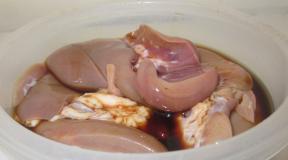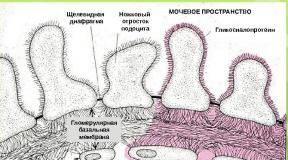Tobacco tar. Tobacco is POISON! Is it possible to clean a smoker's lungs of tobacco tar?
Every person knows that smoking is harmful to health. But such knowledge does not at all prevent a huge number of smokers from buying more and more packs of cigarettes every day, poisoning themselves and others with harmful tobacco smoke. According to doctors, addiction to nicotine quite often causes the development of a variety of ailments, including those that can cause death. But how exactly does smoking harm your health? Let's try to understand what the effect of tobacco smoke on the body is.
Smoking is accompanied by dry distillation and incomplete combustion of tobacco leaves, which leads to the release of smoke, which is a source of various gases and tiny drops of tar. Scientists have found that tobacco smoke contains about four thousand different chemical compounds, two hundred of which are the most toxic and can cause diseases associated with nicotine addiction.
Certain particles of tobacco tar that cause cancer are considered the most destructive for our body. These are polycyclic aromatic hydrocarbons, as well as radioactive isotopes, phenols, nitrosamine, benzopyrene, etc. Moreover, the amount of carcinogens inside tobacco smoke is determined by the type of tobacco, its growing conditions, processing methods, and also the method of smoking. So the higher varieties of leaves of this plant contain much less aggressive substances than the lower ones. So the toxicity of tobacco smoke is determined by the type of tobacco product and smoking methods.
Despite the fact that tobacco smoke is a source of a wide variety of aggressive particles, its most important element is considered to be nicotine, which has the pharmacological effects characteristic of tobacco. This substance has quite strong toxic properties. It quickly breaks down inside our body, and causes the development of addiction. Nicotine detoxification is carried out in the liver, in this organ this chemical element is converted into the less aggressive cotinine.
Nicotine is perhaps one of the most well-known poisons. It has an aggressive effect on the central as well as the peripheral zone of the nervous system, especially affecting the ganglia in the autonomic nervous system. This element has a two-phase effect, first causing excitement and then depression. At first, nicotine stimulates the excitability of the nervous system, causing mild euphoria. A smoker can be distracted from troubles and everyday worries, feeling a little intoxicated and warm. He may also experience less fatigue and a feeling of relief. A similar effect occurs against the background of suppression of the activity of the cerebral hemispheres, as well as suppression of active thinking and memory. The short-term excitement caused by tobacco smoke is soon replaced by a general depression of the central nervous system.
Nicotine has an exciting effect on the adrenal gland receptors, which leads to stimulation of the synthesis of adrenaline, as well as norepinephrine. As a result, the heart rate increases, blood pressure increases, the contractile force of the heart muscle increases, and oxygen consumption increases. Such processes have a positive effect on the individual’s mood, making him feel complete well-being and calm.
Also, the hormones released lead to an increase in the amount of sugar and free fatty acids in the blood plasma, which increases the likelihood of developing atherosclerosis.
Tobacco smoke is not only a source of toxic elements, it also has an irritating effect on the mucous membranes of the oral cavity, as well as the upper respiratory tract. This effect is explained by the presence of acrolein in smoke, which is what causes the well-known smoker’s cough. Its entry into the body leads to the release of sputum and to the narrowing of the lumen of the bronchi, which should be considered as a protective reaction of the body to the effects of irritants. Long-term smoking is fraught with the development of a chronic type of bronchitis, as well as pulmonary emphysema.
Tobacco smoke contains a number of poisonous gases, some of which can combine with our hemoglobin, reducing its ability to transfer oxygen to the cells of the body. This is fraught with the development of a chronic type of oxygen starvation, and subsequently with the occurrence of various ailments of the heart and blood vessels.
Tobacco smoke has a particularly negative impact on the health of children and adolescents. Such smokers develop excessive irritability, memory deteriorates, and concentration of visual perception decreases. At a young age, smoking leads to developmental delays.
Tobacco smoke is also extremely dangerous for women expecting a child and breastfeeding. So, smoking during pregnancy affects the body weight of the fetus, its growth, and development, especially the state of the baby’s nervous system.
It must be taken into account that the impact of tobacco smoke on a person will be equally aggressive during both active and passive smoking. Thus, being in a smoky room leads to a non-smoking individual inhaling all the toxic components of tobacco smoke.
Thus, the effect of tobacco smoke on the body is negative on the condition of all organs and systems not only of the smoker himself, but also of his loved ones.
While inhaling the fragrant smoke of a cigarette, many do not think about what changes each puff causes in the body.
Hot tobacco smoke primarily affects tooth enamel; over time, microscopic cracks appear on it - entry gates for pathogens.Tobacco tar is deposited on the teeth, and they turn black and emit a specific odor, which is clearly felt when talking with a smoker. Hot smoke burns the mucous membranes of the mouth and nasopharynx. Being subjected to constant irritation, they become inflamed, which can lead to the development of leukoplakia, a precursor to cancer.
The salivary glands of the oral cavity also react. As a result, increased secretion of saliva begins, which the smoker is forced to either constantly spit or swallow. But he swallows not just saliva, but part of the toxic components of tobacco smoke dissolved in it. Aniline, hydrogen sulfide, ammonia, and carcinogenic substances enter the gastric mucosa with saliva, which does not go unnoticed. Loss of appetite, pain in the stomach, gastritis, stomach and duodenal ulcers, stomach cancer - this is what constant tobacco intoxication of the digestive organs ultimately leads to.
But the harmful effects of tobacco smoke don’t stop there. From the oral cavity through the vocal folds (which will inevitably affect the smoker’s voice in the future), it rushes to the mucous membranes of the larynx, trachea, bronchi, bronchioles and, finally, alveoli. They are exposed to the most destructive effects of tobacco combustion products. The main ones are ammonia and tobacco tar. Ammonia, dissolving in the moisture of the mucous membranes of the upper respiratory tract, turns into ammonia. By irritating the mucous membranes, it causes increased secretion of mucus, which causes an increase in smoker's bronchitis.
 A tobacco tar settles on the walls of the airways, accumulates in the alveoli, coloring the lungs a dirty brown color, and is also released when coughing with grayish sputum. Tobacco tar contains the highest concentration of carcinogenic substances - benzopyrene, radioactive polonium, lead and bismuth, and it is their harmful effects that significantly increase the risk of lung cancer in smokers.
A tobacco tar settles on the walls of the airways, accumulates in the alveoli, coloring the lungs a dirty brown color, and is also released when coughing with grayish sputum. Tobacco tar contains the highest concentration of carcinogenic substances - benzopyrene, radioactive polonium, lead and bismuth, and it is their harmful effects that significantly increase the risk of lung cancer in smokers.
One of the main components of tobacco smoke, carbon monoxide, rushes through the airways to the alveoli, where the process of exchanging carbon dioxide carried by the blood from the tissues to the lungs for oxygen coming from the air during breathing takes place.And the smoker’s blood is enriched here not so much with oxygen as with carbon monoxide. Combining with hemoglobin, it forms the so-called carboxyhemoglobin - a dummy molecule, unable to carry each cell of our body the oxygen it needs.
 This is why a person who has smoked several cigarettes in a row or is in a smoky room develops oxygen starvation, manifested by headache, dizziness, nausea, and pale skin.
This is why a person who has smoked several cigarettes in a row or is in a smoky room develops oxygen starvation, manifested by headache, dizziness, nausea, and pale skin.
And it happens that your hands suddenly begin to tremble, your gait becomes uncertain, you feel hot or cold, your heart either “thumps” or freezes in your chest... What happened? This began its destructive effect on the central nervous system and on the body as a whole; nicotine is one of the most powerful tobacco poisons. Easily penetrating through the alveolar-capillary partitions following carbon monoxide, it entered the blood and is now distributed throughout the body:tobacco aggression reaches its apogee.
Each organ reacts differently to tobacco smoke. The adrenal glands are the first to send a distress signal. They release adrenaline into the blood, a substance that strongly constricts blood vessels. As a result, blood pressure increases, which can lead to hypertension in smokers. Through narrowed vessels, blood flows through the heart with great difficulty and in a much smaller volume. Under such conditions, it is forced to increase the number of contractions in order to push the required amount of blood to the organs and tissues. For such stimulation of the body, the smoker will sooner or later have to pay with atherosclerosis of blood vessels, coronary heart disease, angina pectoris and even myocardial infarction.
 Blood depleted of oxygen and “enriched” with nicotine causes spasm of blood vessels in the brain.
This is manifested by headache, heaviness in the back of the head, and increasing fatigue. Chronic spasm of peripheral vessels in a heavy smoker can cause obliterating endarteritis, accompanied by lameness and gangrene of leg tissue.
Blood depleted of oxygen and “enriched” with nicotine causes spasm of blood vessels in the brain.
This is manifested by headache, heaviness in the back of the head, and increasing fatigue. Chronic spasm of peripheral vessels in a heavy smoker can cause obliterating endarteritis, accompanied by lameness and gangrene of leg tissue.
Tobacco smoke and smoking also have an adverse effect on the endocrine system. Under the influence of chronic tobacco intoxication, structural depletion of the endocrine glands gradually develops. And this can cause sexual dysfunction and infertility, diabetes and other diseases.
Smoking, including passive smoking, is especially dangerous for a pregnant woman, since nicotine, freely penetrating through the placenta into the blood of the fetus, disrupts its normal development.
Contains tobacco tar, the monthly “norm” of consumption of which by the average smoker is 70 milliliters (when smoking one kilogram of tobacco). At the same time, we must not forget about passive smokers; they are also consumers of tar.
The following statistics are widely known: during an hour of staying in a smoky room, the nicotine content in the blood of a non-smoker increases eight times. In this case, all organs suffer without exception, incl. heart, lungs, liver.
One of the reasons for the deterioration of well-being and health, both active and passive, is tobacco tar.
What is tobacco tar?
A little history. In 1561, the French ambassador to Portugal, Jean Nicot, initiated the spread of tobacco in Europe; it was he who sent plant seeds to the royal court with a recommendation to use the dried plant to fumigate patients with rheumatism, asthma and other diseases. The alkaloid got its name in honor of Jean Nicot. Tobacco tar was named by analogy with the method of producing ordinary tar.
The formation of this substance occurs during smoking, its solid microparticles enter the respiratory system. Each cigarette smoked is a supplier of one billion two hundred thousand particles of tar, which are unevenly deposited on the tissues of the respiratory organs in the form of a carcinogenic resin that can cause mutations and neoplasms, more often of an oncological nature.
Facts about carcinogenic tar. In its composition you can find benzene, simple and complex phenols, cresols, naphthols, naphthalene, toxic gases such as carbon monoxide, nitrogen oxide, hydrocyanic acid, ammonia, as well as heavy metals such as cadmium, mercury, lead, chromium.
It is not surprising that tar over time turns the mucous membranes covering the lungs into an unpleasant sticky mass that makes breathing difficult.
The effect of tar on the human body
As toxins in the tar penetrate, successive dysfunctions occur in everything that comes in their way: the irritated mucous membranes of the gums and tongue become inflamed, becoming a place where bacteria are concentrated, the lungs worsen their function, the liver suffers from intoxication.
Arguments from dentists. A group of St. Petersburg researchers discovered a relationship between the pathological processes occurring in the mouths of smokers and a large volume of a microbe such as tannerella, which is responsible for the accelerated formation of tartar, frequent caries and yellowed and cracked enamel.
Penetrating into blood vessels, toxins reduce the elasticity of their walls, allowing cholesterol plaques to lead a most free existence, which makes the cardiovascular system susceptible to thrombosis, varicose veins, hypertension, and then coronary heart disease.
Some of the harmful substances end up on the mucous membranes of the stomach, causing increased secretion of gastric juice, and subsequently gastritis and ulcers. The liver has to work hard to fight poisons, and additional loads have a detrimental effect on its condition and on the activity of the pancreas.
Thanks to the penetrating capabilities of tobacco tar, the sulfur-containing amino acid homocysteine accumulates in the body. This substance has an effect on numerous pathologies of the fetus in pregnant women and on the development of neuropsychiatric diseases, which was proven long ago by Academician Sechenov.
And at this time it begins to affect the brain: thanks to this, the smoker feels extraordinary relaxation, stimulation of intellectual capabilities, all stress is suppressed, there is not the slightest feeling of hunger, everything is high!
Nicotine and tobacco tar are the main provocateurs of “forgetfulness of pain,” the root causes of which must be treated, and not hidden behind a narcotic veil.
How much tar passes through a smoker's lungs?
Over the course of a year, a smoker passes through himself 81 kilograms of tobacco tar, over ten years - about 8 liters of this carcinogen passes through the lungs, it accumulates in the peripheral parts of the trachea, bronchi and alveoli, which leads to changes in the ciliary carpet of the bronchi, deterioration of the protection of the alveolar partitions and other consequences. But the main thing is that, adapting to such difficult living conditions, the human body makes changes to cells, making them deadly cancerous.
What do smokers need to know? The President of the Anticancer Society of Russia D.N. Zaridze was actively involved in the problems of the content of carcinogenic substances in tobacco smoke and the need for established hygienic standards. Interestingly, based on these studies in Finland, Sweden, England and other countries, the tar content of cigarettes was reduced to 7-14 milligrams. Unfortunately, for Russian smokers, the change in tar content standards was not of decisive importance, because the raw materials for cigarettes are often non-certified components. Manufacturers often keep secret those substances that serve as cigarette flavors.
Inhaled tobacco smoke threatens, for example, children with dire consequences for the brain. This is another factor confirming the negative impact of tobacco tar on the body of a passive smoker.
Researchers from the Parisian INSERM laboratory tested 5,200 primary school students and their parents, as a result of which it was proven that the number of children who are passive smokers in families with smoking parents and who have behavior problems is twice as high as the number of children whose parents do not smoke!
Is it possible to cleanse a smoker's lungs of tobacco tar?
Now is the time to think about what? The answer is optimistic - yes, but only if the smoker has given up his bad habit. Cleansing will occur in three to four months, but the respiratory organs will be able to restore their functions in about a year. Years of violence against the body will not be in vain, and it will be truly stressed during the cleansing process.
There are ways to speed up cleansing and reduce the effects of stress. Among folk remedies, doctors are very supportive of onion and garlic syrup, various herbal decoctions and tinctures, and a milk decoction of oats. Physiotherapy includes cleansing in a sauna or steam bath.
The greater the volume of sputum released by the body, the better for the human body!
Here are some priceless recipes you can use!
For two glasses of milk, one glass of oats (not cereal!). Cook over high heat until it boils, then over low heat until done. Readiness is determined by measuring the volume of remaining liquid: it will be half as much. The resulting substance must be ground and consumed.
Herbal infusion of violet and oregano. It is also prepared in a ratio of one to two (two glasses of water per glass of a mixture of dry herbs), after boiling, turn off the fire and let it brew for a couple of hours. You can use other herbs: primrose, poppy, pine buds, elderberry, sweet clover, and so on.
Onion syrup is prepared by chopping onions and adding granulated sugar in arbitrary proportions. In a jar left in the dark, the sweet juice that has been released will be visible; by straining it, you will get the medicine you are looking for.
Do not forget that such advice must first be agreed with your doctor.
Tobacco smoke is a hot mixture of harmful gases, vapors, liquids and solids resulting from the combustion of tobacco leaves. Measurements have shown that at the end of a cigarette, a cigarette, and especially a cigar, The temperature is very high (600 - 900°C). Wherein Dry distillation of tobacco occurs (pyrolysis). Many organic substances burn to gaseous products, some liquids evaporate, and solids turn into fine microscopic dust, forming harmful substances. Thus, tobacco smoke is an aerosol of gases, liquids and solids.
The chemical composition of tobacco smoke is very complex. In favorDepending on the quality, grade and composition of tobacco, 1200 components are distinguished.
Harmful gaseous components of tobacco smoke include: carbon monoxide ( II) (carbon monoxide) and carbon dioxide, ammonia, hydrogen sulfide, formaldehyde, methane, arsenic oxide ( III), ethane, nitric oxide(I ) etc. It should be borne in mind that even normally harmless substances are toxic when hot and sprayed.
Compared to gaseous fractions of tobacco smoke, they are more diverse and toxic. Of the liquid substances that have a toxic effect on the body, more than 30 different ones have been found in tobacco smoke. acids, over 20 alcohols, 27 aldehydes and ketones, 65 ali phatic hydrocarbons and 45 phenols that form tank tar, essential oils. Among the many kitties lot of tobacco smoke, especially strong poisons are hydrocyanic, formic and oil.
Hydrocyanic acid is a deadly poison. One drop of it is enough to instantly kill a person; it paralyzes cellular and tissue respiration. Despite the fact that the content is hydrocyanic; There is little acid in the smoke, it increases oxygen starvation and disrupts metabolism in the brain, heart and muscle tissues. Acids severely irritate the mucous membrane of the respiratory tract and alveoli, facilitating the penetration of tobacco poisons into the blood and causing inflammation of the larynx, pharynx, and upper respiratory tract.
Of the sublimating alcohols, the poisons are methyl high, ethyl, propionic, butyric and higher polyhydric alcohols, called fusel oils. They poison the lung tissue, easily penetrate the blood, especially affecting the nervous system. Aldehydes and ketones are harmful breakdown products of organic substances; pain Most of them have a bitter aftertaste. Together with water sulfide genus and nicotine, they cause profuse salivation, nausea and vomiting.
Aliphatic hydrocarbons and phenols (among them benzopyrene and benzathracene), which are part of tobacco tar, lead to malignant neoplasms.
Tobacco tar and tar easily stick to thinthe inner membranes of the pulmonary tract and alveoli, prevent promoting normal gas exchange between the lungs and blood. When deposited on the teeth and gums, tar leads to inflammation of the oral mucosa, the formation of brown plaque and tooth decay, which causes bad breath.
By affecting the autonomic functions of the body, nicotine changes the secretion of the adrenal glands, increasing the release of the hormone adrenaline and its effect on the heart and blood vessels. Therefore, when smoking, the heart rate sharply increases, and at the same time, peripheral blood vessels narrow for a long time. In a minute, the frequency of contractions increases by 20-30 beats, and vascular spasm sharply increases blood pressure, disrupts the nutrition of tissues and muscles, the brain, kidneys, liver, and skin.
Nicotine is a poison that stops conduction excitations through nerve nodes. In the whole organism disruption of such transmission interferes with the nervous regulation of the cardiovascular, respiratory, excretory and other systems, metabolism, and endocrine glands. It has been established that nicotine interferes with the body’s absorption of vitamin C, destroying it, causing increased deposition of lime and cholesterol in the walls of blood vessels, which leads to sclerotic changes.
Nicotine is especially harmful to the body during muscle activity, as it disrupts blood circulation and the regulation of vital organs and muscle tissue itself. At the same time, the harm of smoking can be reduced only to nicotine would be too one-sided. Nicotine is only one of the main poisons, the narcotic effect of which creates a craving for smoking and the formation of a harmful, unhygienic habit that turns into a disease - nicotine addiction. You should also pay attention to other components of tobacco smoke, which poison the body, reduce its protective properties, impair growth and development, contributing to the occurrence of various diseases.
There are fewer solid fractions in tobacco smoke than gaseous and liquid ones, but their effect on the body is even more destructive. These fractions include: arsenic compounds, radioactive and carcinogenic substances, soot. It is estimated that 1 ml of tobacco smoke contains 600,000 small dust particles of soot. They clog the lung tissue and make breathing difficult. Arsenic oxide ( III) is an extremely toxic compound that poisons the lungs and nervous system.
Scientists have discovered radioactive polonium (210 Po) in tobacco smoke with a decay period of 138 days. When smoking tobacco, 80% of polonium passes into the smoke. It emits alpha (a) particles. When smoking two packs of cigarettes, a person emits 36 rads of radiation, and the permissible dose established by the International Council on Radiation Protection is 6 rads. Considering that tobacco smoke also contains radioactive lead C 20 Rv), bismuth (210 Bi ), (40 K ), emitting beta (B) particles, then the total radiation when smoking a pack of cigarettes reaches 50 rad. This is quite enough to cause cancer of the lips, larynx, lungs and other organs with long-term smoking. In the lungs of smokers, 7 times more radioactive polonium was found than in non-smokers, in the liver - 3 times, in the heart - 2 times, in the kidneys - 1.5 times. Many scientists believe that the presence of these substances is more dangerous than the effects of other substances in tobacco smoke combined.
Thus, when smoking, the body is affected by many substances in a hot mixture of gases, vapors and dust. They easily penetrate into the blood, and through the walls of capillaries into all cells, tissues and organs.
Cultivating students' intolerant attitude towards smoking should begin with an explanation of the composition of tobacco smoke and disclosure of the toxic effect of its components on all organs and systems of the body.
The effect of tobacco smoke on the human body has been studied in physiological, toxicological and social terms.
Physiological studies have made it possible to clarify the effect of smoking and tobacco smoke on all systems and organs we of a person, on his mental and physical performance property.
Toxicological studies have proven that tobacco smoke and its individual components have a toxic effect on living organisms and have revealed the mechanism of acute and chronic poisoning from smoking.
Smoking, depending on the strength of tobacco, its doses, duration of action, leads to acute or chronic nic poisoning of the body. Acute poisoning is a sudden disruption of the vital functions of the body as a result of a single smoking of a large amount of tobacco.
The first introduction into the body of a whole complex of toxic substances from tobacco smoke causes a sharp defensive reaction: salivation and lacrimation, nausea, breath holding, coughing with simultaneous disruption of the nervous, respiratory, circulatory and other systems. The composition of the blood changes sharply, which has a strong effect on the medulla oblongata.
Acute poisoning is accompanied by a brain disorder blood circulation, spasm of the heart vessels, sleep decreased body temperature, clouding or loss of consciousness. To provide first aid to the victim, follow blows, lay on your back and apply cold cold ones to your forehead compresses, and in case of cardiac arrest - perform artificial respiration, massage the heart area, and then send it to a medical facility.
Acute poisoning is especially dangerous for children and adolescents, whose protective properties and resistance to adverse conditions are much lower than in adults.
Chronic poisoning causes painful changes understanding of structural, morphological and functional character arising as a result of prolonged smoking. In case of chronic poisoning, the activity of all vital organs and systems is disrupted, performance decreases, sexual impotence occurs, premature aging occurs, growth and development of the body is delayed in children. Smoking children and teenagers ki do not tolerate infectious diseases well, themlower protective functions and immunity of the body are present, they are not resist bacterial poisons and cannot withstand prolonged exposure to high temperatures. It should be emphasized that it is harmful for protective functions and immunity but not only smoking itself, but also being in smoky premises.
It can be represented as a series of direct and indirect means of attacks on the main systems of the body.
Read also...
- Why do you dream about a man’s back?
- Fortune telling with hearts online: a simple and free way to tell fortunes about a guy’s love
- Dream Interpretation: flying above the ground in a dream
- Description of orange zest with photo, its calorie content; how to make at home; use of the product in cooking; harm and beneficial properties


















